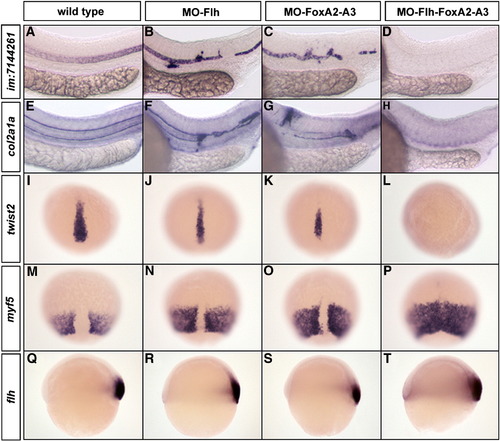
Flh and FoxAs transcription factors are both essential for the maintenance of axial structures. (A–H) Expression at 24 hpf of the notochord marker im:7144261 (A–D) and the floor plate and hypochord marker col2a1a (E–H). Embryos injected with low dose of MO-Flh (0.8 ng) (B and F) or MO-FoxA2–FoxA3 (3 x 4 ng) (C and G) display weak phenotypes compared to wild-type (A and E). With the same amount of morpholinos, the triple inactivation of Flh, FoxA2 and FoxA3 completely abolishes notochord (D), floor plate and hypochord (H) development. (I–P) Expression at 80% epiboly of the chordamesoderm marker twist2 (I–L) and paraxial mesoderm marker myf5 (M–P). Partial Flh (J and N) or FoxA2–FoxA3 (K and O) morphants show a slight reduction of axial mesoderm. Partial Flh-FoxA2–FoxA3 triple morphants lack all axial mesoderm (L) that is accompanied by a complete fusion of paraxial mesoderm along the dorsal midline (P). (Q–T) Expression of flh at the shield stage in strong Flh (R), FoxA2–FoxA3 (S) and Flh-FoxA2–FoxA3 (T) morphants is similar to wild-type embryo (Q). (A–H) Lateral views, anterior to the left. (I–P) Dorsal views, anterior up. (Q–T) Lateral views, dorsal to the right.
|

